DACF Home → Bureaus & Programs → Maine Natural Areas Program → Communities, Plants, and Animals → Invasive Plants → Japanese Knotweed
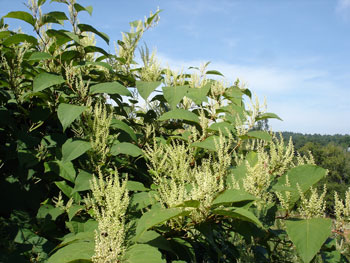 Japanese knotweed
Japanese knotweed
Japanese Knotweed
(Mexican bamboo)
Fallopia japonica
2019 Status in Maine: Widespread. Severely Invasive.
Description: Robust, very tall (to 10') perennial herb growing in dense stands. Leaves: Simple, alternate, entire, flat at base and abruptly tapering to pointed tip, ~6" long and 3-4" wide. Flowers: Small, white, abundant, in small spikes along stems, late summer in Maine (late July or August). Fruits: Small, (<½") with thin "wings" to enable wind dispersal. Stem: 1-2" diameter, round, hollow, with swollen nodes where leaves meet the stem. Dead, brown-red stalks persist through winter.
Native range: Eastern Asia. How arrived in U.S.: As an ornamental; also for fodder and erosion control.
Reproduction: Mostly by fragments of living stem or rhizome. Fertile seeds are sometimes produced, and all seed should be treated as potentially viable. Can sprout from any stem node or rhizome fragment.
Habitat: Open uplands, riverbanks, lakeshores, forest edges, disturbed areas within the forest. Extremely adaptable, tolerant of dry to seasonally saturated soils. Especially problematic along larger rivers where spring flooding transports live rhizomes downstream.
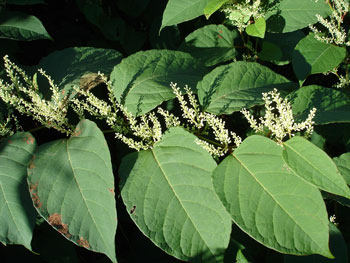 Japanese knotweed branch, note zig-zag shape of stem
Japanese knotweed branch, note zig-zag shape of stem
Similar native species: None in our area.
Similar non-native species: Giant knotweed (Fallopia sachalinensis) is typically taller than Japanese knotweed (to 12') and has larger leaves with heart-shaped bases that taper more gradually toward the tip. The two species hybridize (F.x boehemicum), and can back-cross. Giant knotweed and the hybrid are also invasive.
Fact Sheets and Identification Links
- Kings County, Wisconsin, link to several videos, the first is about identification
- Go Botany page for Fallopia japonica
- New Hampshire Department of Agriculture, Markets & Food Preventing the Spread of Japanese Knotweed
- PennState Extension Japanese Knotweed
- Michigan DNR Best Control Practices Japanese Knotweed
Control Methods
New patches (<20 stems) can be cut repeatedly throughout the growing season*, as often as once/week, for several years. Larger patches cannot be controlled manually without a persistent, reliable labor source. Smothering with heavy black landscaping cloth or erosion control fabric can be successful but requires biweekly maintenance and must be repeated for up to 10 years; see references for sources of information on this method. Herbicides† are effective. For small patches, use stem injection or cut-drip applications of glyphosate*. Be sure to dispose of cut stems carefully. For large patches, cut or mow when plants are approximately 3' tall, then apply glyphosate as foliar spray when plants have re-grown to 3-5' tall later in the same growing season, or apply to uncut, mature stems just before flowering. Avoid application of foliar herbicide during flowering as bees are attracted to this species. Follow-up will be needed in almost all circumstances. Special rules apply to herbicide use in or near wetlands and water bodies - consult the Maine Board of Pesticides Control.
* Correctly dispose of all plant parts↵ † Follow all label directions when using herbicides↵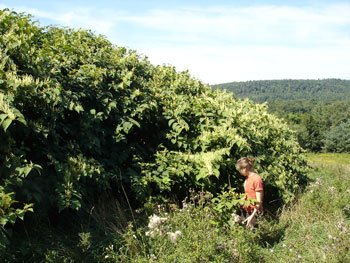 Japanese knotweed plant, which is a single clone
Japanese knotweed plant, which is a single clone
Control Technique Video Demonstrations
- Kings County, Wisconsin (10:00 total), several videos explaining mechanical and chemical methods, including herbicide stem injection
- USFWS West Virginia Field Office (6:30), ecology of species, cutting to manage height for herbicide application
Please email invasives.mnap@maine.gov if you have questions about invasive species in Maine
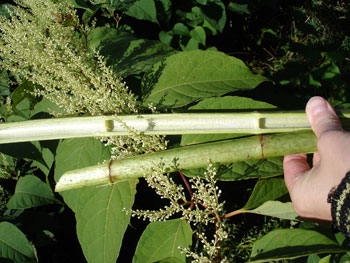 Japanese knotweed cut stem, showing hollow center and node
Japanese knotweed cut stem, showing hollow center and node
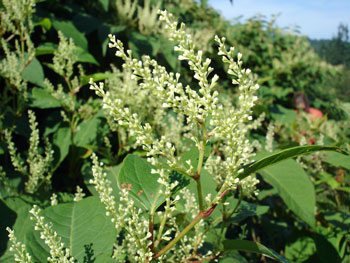 Japanese knotweed flowers
Japanese knotweed flowers
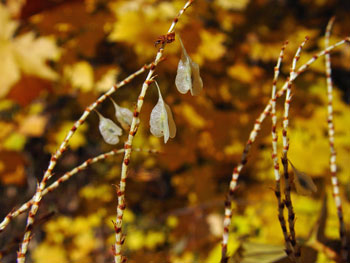 Japanese knotweed fruit
Japanese knotweed fruit
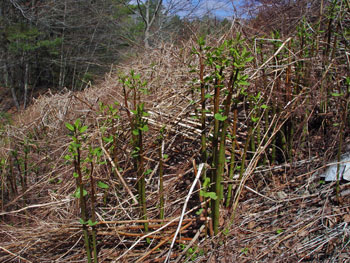 Japanese knotweed shoots
Japanese knotweed shoots